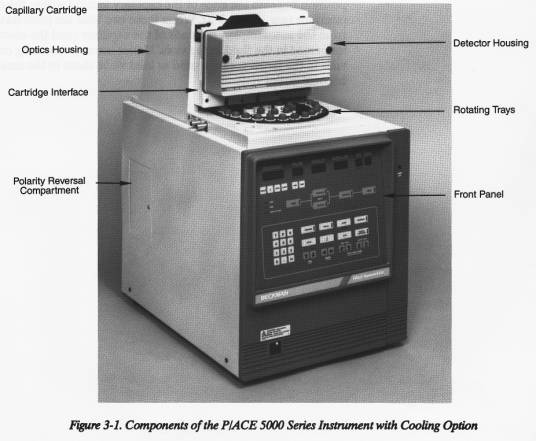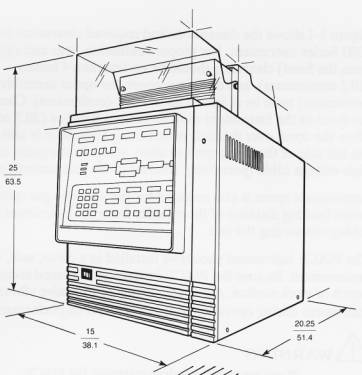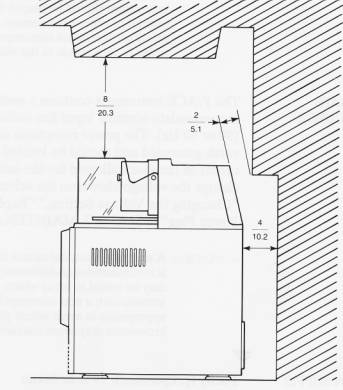Beckman P/ACE 5000
| Objektnummer | B00013689 |
|---|---|
| Numéro d'identification | 013689 |
| Nom de l'objet | Beckman P/ACE 5000 |
| Statut | Stock unit |
Groupe de produits: Électrophorèse capillaire
Statut, conditions de livraison et de paiement
Vérification des appareils
Les appareils d’occasion sont vérifiés par Labexchange Service GmbH avant la livraison. Vous recevez des appareils entièrement fonctionnels.
Délai d'expédition
Les délais de livraison indiqués sont les plus rapides pour l’article en cause. Les délais de fait peuvent varier au cas par cas. Les délais de livraison définitifs sont indiqués dans la confirmation de commande.
Nous offrons des livraisons collectives par principe. Le délai de livraison s’oriente à l’article avec le délai de livraison le plus long. Une livraison partielle est possible par prix additionnel.
Méthodes d'expédition
Courrier, agences d'expédition, autocueillette, livraison par flotte de Labexchange
Conditions de livraison
Prix plus frais d’expédition. Les frais d’expédition indiqués sont à prévoir. Dérogations éventuelles sont possibles.
Si les coûts de transport ne sont pas spécifiés, s'il vous plaît demander séparément les frais de transport. Les frais de transport et d'emballage indiqués se réfèrent à l'itinéraire de transport le moins cher et sont sujets à des augmentations de coûts imprévues. En raison d'événements imprévisibles, les tarifs de transport et les délais de livraison peuvent changer à tout moment et doivent être adaptés à la situation actuelle. Incoterm codage selon les Incoterms 2010: Pour personnes qui viennent chercher les dispositifs elles-mêmes: EXW, pour les expéditions par voie maritime: CFR, par avion: CPT, d'autres expéditions: DAP. Remarque: Nous n'établissons pas des preuves préférentielles/EUR1. Dans le cas d’un enlèvement par vos soins/EXW de pays à l’intérieur ou à l’extérieur de la Union européenne, nous devons conserver 16% de TVA d’acheteur comme dépôt de garantie, jusqu’à ce que nous ayons reçu l’attestation de reception/la prevue de livraison.
Modalités de paiement
Nous n’acceptons pas le paiement par lettre de credit, PayPal, etc. Dans tous les cas le montant est payable sans déduction. Jusqu’au paiement complèt l’équipement reste notre propriété. Un escompte n’est pas accordé.
|
Pays |
Modalités de paiement possible |
Remarque |
|
DE, AT, CH |
Paiement par facture, prépaiement, par carte de credit |
Paiement par facture est possible pour clients professionnels. |
|
NL, BE, LU |
Paiement par facture, prépaiement, par carte de credit |
Paiement par facture est possible pour clients professionnels. |
|
Autre pays |
Prépaiement, par carte de credit |
|
Nos conditions de vente, de livraison et de paiement sont en vigueur. Vous pouvez télécharger les documents ici.
La vente intermédiaire nous est réservée.
Défintion des statuts
Tous articles sont d’occasion, sauf si explicitement défini comme « appareil neuf ».
|
Statut |
Condition |
Remarque |
|
Immédiatement disponible |
Occasion |
L’article a été déjà entièrement vérifié et peut être envoyé directement à vous. |
| En stock |
Occasion |
L'article est en notre stock, mais doit être vérifié avant la livraison par nos techniciens Vous recevez des articles entièrement fonctionnels. |
|
Publié |
Occasion |
L’article est toujours au l’offreur. Nous achetons, vérifions et en fin livrons l’article après votre commande. Le certificat de fonctionnement ainsi que le rapport de service sont inclus à la livraison. |
|
Appareil neuf |
Neuf |
C’est un dispositif neuf. L’article n’est pas utilisé et neuf d’usine. En ce qui concerne des article neufs, la garantie du fabricant est valable. |
|
Labprocure |
Occasion |
Responsable du contenu de l‘offre d’appareil est la société Labprocure GmbH, comme annonceur. Labprocure assume la responsabilité des offres annoncées ici ainsi que des photos et des textes d’offre inclus. Labprocure GmbH, Bruckstraße 58, 72393 Burladingen. |
The following illustrations and descriptions are referring to the instrument model and are drawn from brochures. They are not representing the delivery volume. The exact delivery content you will find only in the offering text.
Principles of Operating
Utilizing the electrokinetic principles of electrophoresis and
electroosmosis, the P/ACE 5000 Series instrument separates sample components within a fused-silica capillary. This type of separation is known as high performance capillary electrophoresis (HPCE). In the P/ACE System, sample is injected using either pressure or voltage. Under the influence of high voltage, sample components migrate differentially through the capillary. As these components pass a window in the capillary, a wavelength-selectable UV detector monitors them and transmits a signal (a voltage that is proportional to sample absorbance) to a recorder, integrator, or computer. The signal is then plotted graphically in the form of an electropherogram.
The P/ACE instrument can be used to separate many different kinds of samples, including amino acids, peptides, proteins, DNA fragments, and nucleic acids. Precious and biologically active materials can be separated using this system because efficient separation can be achieved using very small sample amounts (5 to 30 microliters, with the actual injection volume being typically between 10 and 50 nanoliters). Capillary electrophoresis also requires very little time when compared with traditional forms of electrophoresis. Depending upon the length of the capillary used, the applied potential, and the mobility of the sample components, baseline separations can be achieved within a few minutes; typical run times are between 10 and 30 minutes.
P/ACE SYSTEM DESCRIPTION
In the P/ACE instrument, a fused-silica capillary, which is contained within a temperature-controlled cartridge, bridges two electrolyte vials located on an autosampler. The autosampler trays rotate until vials containing the necessary fluids for specific operations are in position beneath the ends of the capillary. The vials are then pneumatically raised so that the ends of the capillary are immersed in the fluid in the vials. Also immersed in one of these vials is a positive electrode (anode) that can deliver up to 30 kV; a negative electrode (cathode) is immersed in the other. *
Sample is injected into the capillary using either pressure or voltage. Pressure injection may be used with free-zone capillaries to avoid sample discrimination based on electrophoretic mobility. Voltage injection is used with gel-filled capillaries that do not permit bulk fluid flow. Continued application of voltage during separation causes sample components to migrate through the capillary at different velocities. Separated sample component zones thus pass by a detector window in the capillary at different times, until all components have passed the detector.
The detector is wavelength-selectable and is located near the outlet of the capillary. It measures the absorbance of each component as it passes and transmits this information to a data system. The data system produces what is known as an electropherogram, which is similar to an HPLC chromatogram in that absorbance values are plotted as peaks, and sample component may be identified by its migration time and may be quantitated by the area under the corresponding peak in the electropherogram.
OPERATION
You can operate the instrument by initiating processes individually or by programming a sequence of processes (methods). The same process values can be run again by simply reinitiating the process or method; alternatively, one or more values can be changed (and retained in memory) before the process or method is run again.
The controller requires that values for various process parameters be entered into memory to perform a process effectively. Required parameters generally include time duration, inlet and outlet vial number, and voltage or current limits. In addition to these process parameters, other types of information can also be entered into the controller memory and some settings can be controlled using certain front panel keys. These other settings include the wavelength to be used during separation, whether high or low pressure will be used during a rinse, the cartridge coolant temperature, the rise time used to reduce noise in the detector signal, the point at which the instrument will automatically calibrate (zero) the detector during a method run, and whether or not multiple repetitions of the same method will be performed automatically.
During a run, all displays show real-time values. The data shown in the DETECTOR OUTPUT display during a separation is filtered to compensate for the eyes" inability to read rapidly changing numeric data. The display can still change quickly, showing changes in absorbance as sample components pass the detector, but not so fast that our eyes cannot perceive the data. The output from the back panel to the data system is not filtered beyond that determined by the selected rise time.

The main components of the P/ACE 5000 Series instrument include an autosampler (two rotating trays) that holds vials of sample and other solutions, a cartridge holder and Interface, a high-voltage power supply and electrodes, an optics module and detector, temperature control hardware, a sample injection mechanism, and a controller with front panel displays and function switches (see Figure 3-1).


SPECIFICATIONS
Dimensions and clearances see Figure 1-1
Weight (uncrated) 100lb (45.4 kg)
Power requirements 50/60 Hz; voltage selectable
Voltage 90130 VAC
or
190254 VAC
Fuse requirements
100-120V P,vo ULJCSA T4/250V: IEC T3.15A/250V
220-240V
'livo UUCSA T2A/250V: IEC 1.6A/250V
Compressed nitrogen requirements
Pressure 80-85 psig (552-586 kPa)
Purity 99% (prepurified)
Max. dew point 0°C (32°F)
Maximum heat dissipation to the room 300 W (1024 Btu/h)
Ambient operating temperature range 4-40°C (39-104°F)
Recommended range for best performance 15-30°C (59-86°F)
Humidity restrictions < 95% (non-condensing)
Pre-rinse time 0 to 99.9 min. (resolution: 0.1 min.)
Post-rinse time 0 to 99.9 min. (resolution: 0.1 min.)
Inject time 1 to 99.9 sec. (resolution: 0.1 sec.)
Separate time 0.1 to 99.9 min. (resolution: 0.1 min.)
Temperature 15 to 50°C* (resolution: 0.1°C)
Inject Voltage 1 to 10 kV
Separate Voltage 1 to 30 kV (resolution
programming 0.1 kV;
operation 0.01 kV)
Current 1 to 250 µA (resolution 0.1 µA
Inlet vial number 11 through 34
Outlet vial number 1 through 10
UV Detector
Wavelength range 190 to 380 nm
Filter selection 200-, 214-, 254-, and 280-nm standard
three open positions for additional
wavelength selections
Filter diameter 1/2-in. (12.7 mm)
UV source deuterium lamp, 30 W
Wavelength accuracy ± 2 nm
Output range (programmable) ± 0.005 to +0.200 AUFS
High Voltage Power Supply
Voltage range 1.0 to 30 kV
Selectable voltage increments 100 V
Display resolution 10 V
Absolute accuracy ± 3%
Repeatability within 0.3%
Current range 1 to 250 µA
Selectable current increments 0.1 µA
Display resolution 0.1 µA
Absolute accuracy 2%
Repeatability within 0.2%
Shipping Test Results
The packaged P/ACE instrument has been subjected to the following tests without degradation to the performance or appearance of the instrument
Drop Free drop 18 inches on all sides
Vibration 15 minutes duration composite "Thick-Air" spectrum at 1.2 g's
RMS with the package oriented on the base and left side; and 15 minutes at the resonant frequency of the package (15 Hz) with the package oriented on the base and back at 1.2 g's RMS.





